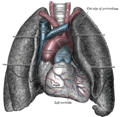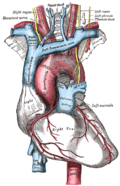Ascending aorta
Ascending Aorta
The ascending aorta is a major part of the human cardiovascular system. It is the initial section of the aorta, the largest artery in the body, which carries oxygenated blood from the heart to the rest of the body.
Anatomy[edit]
The ascending aorta begins at the upper part of the left ventricle of the heart. It extends upward and bends to form the aortic arch. The ascending aorta is approximately 5 cm in diameter and 5 cm in length. It is located in the mediastinum, the central compartment of the thoracic cavity.
Function[edit]
The primary function of the ascending aorta is to carry oxygen-rich blood from the left ventricle to the rest of the body. It does this by branching into the coronary arteries, which supply blood to the heart muscle, and the aortic arch, which carries blood to the head, neck, and upper body.
Clinical significance[edit]
Diseases of the ascending aorta can be life-threatening and include aortic aneurysm, aortic dissection, and aortic stenosis. These conditions can lead to complications such as heart failure, stroke, and even death if not promptly diagnosed and treated.
See also[edit]
References[edit]
<references />
-
Ascending_aorta
-
Ascending_aorta
-
Ascending_aorta
-
Ascending_aorta
-
Ascending_aorta
-
Ascending_aorta
-
Ascending_aorta
-
Ascending_aorta
-
Ascending_aorta
-
Ascending_aorta
-
Ascending_aorta
-
Ascending_aorta
Ad. Transform your life with W8MD's Budget GLP-1 injections from $75


W8MD offers a medical weight loss program to lose weight in Philadelphia. Our physician-supervised medical weight loss provides:
- Weight loss injections in NYC (generic and brand names):
- Zepbound / Mounjaro, Wegovy / Ozempic, Saxenda
- Most insurances accepted or discounted self-pay rates. We will obtain insurance prior authorizations if needed.
- Generic GLP1 weight loss injections from $75 for the starting dose.
- Also offer prescription weight loss medications including Phentermine, Qsymia, Diethylpropion, Contrave etc.
NYC weight loss doctor appointmentsNYC weight loss doctor appointments
Start your NYC weight loss journey today at our NYC medical weight loss and Philadelphia medical weight loss clinics.
- Call 718-946-5500 to lose weight in NYC or for medical weight loss in Philadelphia 215-676-2334.
- Tags:NYC medical weight loss, Philadelphia lose weight Zepbound NYC, Budget GLP1 weight loss injections, Wegovy Philadelphia, Wegovy NYC, Philadelphia medical weight loss, Brookly weight loss and Wegovy NYC
|
WikiMD's Wellness Encyclopedia |
| Let Food Be Thy Medicine Medicine Thy Food - Hippocrates |
Medical Disclaimer: WikiMD is not a substitute for professional medical advice. The information on WikiMD is provided as an information resource only, may be incorrect, outdated or misleading, and is not to be used or relied on for any diagnostic or treatment purposes. Please consult your health care provider before making any healthcare decisions or for guidance about a specific medical condition. WikiMD expressly disclaims responsibility, and shall have no liability, for any damages, loss, injury, or liability whatsoever suffered as a result of your reliance on the information contained in this site. By visiting this site you agree to the foregoing terms and conditions, which may from time to time be changed or supplemented by WikiMD. If you do not agree to the foregoing terms and conditions, you should not enter or use this site. See full disclaimer.
Credits:Most images are courtesy of Wikimedia commons, and templates, categories Wikipedia, licensed under CC BY SA or similar.
Translate this page: - East Asian
中文,
日本,
한국어,
South Asian
हिन्दी,
தமிழ்,
తెలుగు,
Urdu,
ಕನ್ನಡ,
Southeast Asian
Indonesian,
Vietnamese,
Thai,
မြန်မာဘာသာ,
বাংলা
European
español,
Deutsch,
français,
Greek,
português do Brasil,
polski,
română,
русский,
Nederlands,
norsk,
svenska,
suomi,
Italian
Middle Eastern & African
عربى,
Turkish,
Persian,
Hebrew,
Afrikaans,
isiZulu,
Kiswahili,
Other
Bulgarian,
Hungarian,
Czech,
Swedish,
മലയാളം,
मराठी,
ਪੰਜਾਬੀ,
ગુજરાતી,
Portuguese,
Ukrainian












